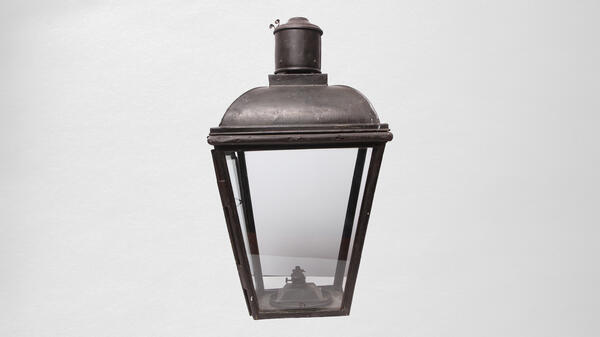The campfire and simple torches were the first illuminating sources for humans; a small clay vessel with live coal inside became one of the first lamps. In due course, the lamps with a wick floating in the oil were invented.
Until the middle of the 19th century, different fats and coal gas were used in the lantern. The light from the oil was bad, produced a considerable amount of soot, carbon deposits, smelled unpleasant, and clogged the lanterns. The lighting gas was poorly adapted for use, and that is why it did not become popular.
In the 1850s, kerosene replaced the oil in lamps. Polish scientist Ignacy Lukasiewicz and pharmacist Jan Zeh were credited with the invention of the kerosene lamp. In 1853, they started to use kerosene in the developed oil lantern. According to their contemporaries, this lamp became an ‘industrial sensation’. The kerosene lantern of the mid-19th century is displayed in the museum collection.
This type of illumination tool quite soon became popular throughout Europe due to low-cost petroleum: kerosene was much cheaper than oil and candles. In addition, kerosene lanterns flame up much brighter.
These lanterns’ mode of operation is as follows: kerosene is poured into the special vessel and a wick was submerged into the fluid. The lifting device in the burner fixed the other end of the wick. Air enters the burner from the bottom, and lamp glass was placed right on the vessel. It ensured air draught and kept the flame safe from the wind.
In order for kerosene to burn down uniformly, the tissue part, from which the smoky lick of flame ascended, was slightly trimmed. This practice was repeated if necessary.
In 1861, kerosene lamps were introduced in Russia and replaced the rest of the illumination tools. As time went by, desk lamps and models equipped with lampshades were manufactured, and fittings for lanterns installation on the wall as well.
Many kerosene lamps surviving to this day are considered by experts as works of art. Desk lamps are of particular interest to the experts. They consisted of a round vase, metal, porcelain, or another material’s base, a big barrel for kerosene, and a lamp glass decorated by a lampshade.
Until the middle of the 19th century, different fats and coal gas were used in the lantern. The light from the oil was bad, produced a considerable amount of soot, carbon deposits, smelled unpleasant, and clogged the lanterns. The lighting gas was poorly adapted for use, and that is why it did not become popular.
In the 1850s, kerosene replaced the oil in lamps. Polish scientist Ignacy Lukasiewicz and pharmacist Jan Zeh were credited with the invention of the kerosene lamp. In 1853, they started to use kerosene in the developed oil lantern. According to their contemporaries, this lamp became an ‘industrial sensation’. The kerosene lantern of the mid-19th century is displayed in the museum collection.
This type of illumination tool quite soon became popular throughout Europe due to low-cost petroleum: kerosene was much cheaper than oil and candles. In addition, kerosene lanterns flame up much brighter.
These lanterns’ mode of operation is as follows: kerosene is poured into the special vessel and a wick was submerged into the fluid. The lifting device in the burner fixed the other end of the wick. Air enters the burner from the bottom, and lamp glass was placed right on the vessel. It ensured air draught and kept the flame safe from the wind.
In order for kerosene to burn down uniformly, the tissue part, from which the smoky lick of flame ascended, was slightly trimmed. This practice was repeated if necessary.
In 1861, kerosene lamps were introduced in Russia and replaced the rest of the illumination tools. As time went by, desk lamps and models equipped with lampshades were manufactured, and fittings for lanterns installation on the wall as well.
Many kerosene lamps surviving to this day are considered by experts as works of art. Desk lamps are of particular interest to the experts. They consisted of a round vase, metal, porcelain, or another material’s base, a big barrel for kerosene, and a lamp glass decorated by a lampshade.



